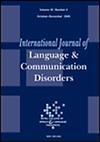Auditory-Perceptual Evaluation of Situationally-Bound Judgements of Listener Comfort for Postlaryngectomy Voice and Speech
Abstract
Background
The influence of the listening environment in which communication occurs has been of longstanding interest related to communication disorders. It also has been posited that specific listening scenarios may differentially effect listener judgements of a speaker. In the case of those who have lost their larynx and normal voice due to cancer, a listener's assessment may carry a substantial penalty. This study was designed to determine if situationally-bound communication ‘scenario’ influences a listener's auditory-perceptual judgement of level of comfort for three modes of postlaryngectomy alaryngeal speech: oesophageal (ES), tracheo-oesophageal (TE) and electrolaryngeal (EL) speech. Additionally, a modified oesophageal speech (MES) group where air insufflation pauses were excluded digitally, was also included; this modification was employed to reduce the potential impact of unusual, non-junctural pauses that may occur in some oesophageal speakers.
Methods and Procedures
Forty-eight speaker samples (12 speakers per alaryngeal group) were evaluated by 22 naïve adult listeners for a dimension termed listener comfort (LC). Judgements assessed all speaker samples based on two implied listening scenarios: (1) a social conversation interaction (LC-Soc) and (2) a telephone conversation (LC-Tel). Both scenarios were rated by listeners using a visual analogue scaling procedure. Ratings were provided in a counterbalanced manner across two sessions separated by 7–10 days.
Outcomes and Results
Listener ratings were not found to differ significantly by listening scenario (social vs. telephone) for any given speech mode. However, significant differences were observed in listener judgements of TE speakers when compared to EL, ES and MES speaker samples for both LC-Soc and LC-Tel listening scenarios. Further, a significant correlation was found between judgements of LC-Soc and LC-Tel, indicating a strong relationship between the two.
Conclusions and Implications
Listeners indicated that they were more comfortable listening to TE speakers when compared to the other postlaryngectomy speech modes that were evaluated. This suggests that in general, a listener's perceived LC may be more favourable to TE speech. Thus, these comparative findings provide objective data on how a listener may respond to postlaryngectomy communication methods and, consequently, may offer valuable insights into the relative merits of these postlaryngectomy communication rehabilitation methods. Collectively, the findings of this study add important information that can assist in both pre- and postoperative counselling for those who undergo laryngectomy.
WHAT THIS PAPER ADDS
- Although information is available on how listeners rate various methods of postlaryngectomy voice and speech, namely esophageal speech (ES), tracheo-oesophageal speech (TE) and electrolaryngeal (EL) speech, as well as how they characterize speakers through auditory-perceptual evaluation, there is little information on the influence of situationally-bound judgements. In this regard, the auditory-perceptual feature termed ‘listener comfort’ (LC) may provide valuable information in relation to different listening scenarios. Thus, efforts that seek to quantify how unique listening situations influence listeners judgements of LC are important. These data may provide new information that would be of benefit to counselling specific to potential communication challenges that may evolve from listener responses to alaryngeal methods and their use in common communication situations.
- This study identified that while listener ratings of LC were not found to differ between the two listening scenarios (social vs. telephone) evaluated, the mode of postlaryngectomy speech and voice must be considered. More specifically, our data revealed significantly better listener judgements of LC were found for TE speakers when compared to the other speech modes for both listening scenarios that were assessed. The data also show that when speech intelligibility is reduced as a potential variable, considerable variability exists both within and across the modes of alaryngeal speech evaluated.
- The present data may provide important guidance relative to counselling of those who undergo total laryngectomy. Those who use any method of alaryngeal voice and speech must be aware that some listeners may react negatively to the quality of their speech. Thus, acknowledging the interaction between both the speaker and the listener is essential. Information related to how listeners may respond to specific modes of postlaryngectomy voice and speech and how specific communication scenarios may influence a listener's response can serve as valuable educational information for both clinicians and those individuals they serve as part of the postlaryngectomy rehabilitation process. Although speakers are unable to directly modify a listener's reaction to their postlaryngectomy voice quality, they may be able to directly acknowledge their challenges, which may reduce the burden on listeners in communication interactions. Thus, these data may serve to expand the extent of information provided in both pre- and postoperative laryngectomy counselling.

 求助内容:
求助内容: 应助结果提醒方式:
应助结果提醒方式:


